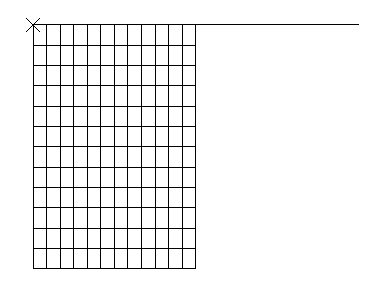Geometry and model
The geometry is the standard test case of Lippmann (1979) and is defined in Upsetting of a cylindrical billet: coupled temperature-displacement and adiabatic analysis. It is a circular billet, 30 mm long, with a radius of 10 mm, compressed between two flat, rigid dies that are defined to be perfectly rough.
The mesh used to begin the analysis is shown in Figure 1. The finite element model is axisymmetric and includes the top half of the billet only since the middle surface of the billet is a plane of symmetry. In both the Abaqus/Standard and Abaqus/Explicit simulations, element type CAX4R is used: this is a 4-node quadrilateral with a single integration point and “hourglass control” to control spurious mechanisms caused by the fully reduced integration. The element is chosen here because it is relatively inexpensive for problems involving nonlinear constitutive behavior since the material calculations are only done at one point in each element. In addition, in the Abaqus/Standard simulations element types CGAX4R, CGAX4T, CAX4P, and CAX4I are also used to model the billet; in the Abaqus/Explicit simulations element type CAX6M is also used to model the billet.
The contact between the top and lateral exterior surfaces of the billet and the rigid die is modeled with a contact pair in Abaqus/Standard and with general contact in Abaqus/Explicit. The billet surface is specified as a surface definition in the model. The rigid die is modeled in a variety of different ways as described in Table 1. The mechanical interaction between the contact surfaces is assumed to be nonintermittent, rough frictional contact. Therefore, the contact property includes two additional specifications: rough friction to enforce a no-slip constraint between the two surfaces, and a no-separation contact pressure-overclosure relationship to ensure that separation does not occur once contact has been established. All the contact simulations in Abaqus/Standard use the node-to-surface formulation except one case where the surface-to-surface formulation is introduced.
Table 1 summarizes the different analysis cases that are studied. The column headings indicate whether the problem was analyzed using Abaqus/Standard and/or Abaqus/Explicit.
For Case 1 several different analyses are performed to compare the different section control options available in Abaqus/Explicit and to evaluate the effects of mesh refinement for the billet modeled with CAX4R elements. A coarse mesh (analysis COARSE_SS) and a fine mesh (analysis FINE_SS) are analyzed with the pure stiffness form of hourglass control. A coarse mesh (analysis COARSE_CS) is analyzed with the combined hourglass control. A coarse mesh (analysis COARSE_ENHS) and a fine mesh (analysis FINE_ENHS) are analyzed with the hourglass control based on the enhanced strain method. The default section controls, using the integral viscoelastic form of hourglass control, are tested on a coarse mesh (analysis COARSE) and a fine mesh (analysis FINE). Since this is a quasi-static analysis, the viscous hourglass control option should not be used. All other cases use the default section controls.
The Abaqus/Standard analyses for Case 1 compare the two hourglass control options and evaluate the effect of mesh refinement for the billet modeled with CAX4R elements. A coarse mesh (analysis COARSE_S) and a fine mesh (analysis FINE_S) are analyzed with the pure stiffness form of hourglass control. A coarse mesh (analysis COARSE_EH) and a fine mesh (analysis FINE_EH) are analyzed with hourglass control based on the enhanced strain method. A coarse mesh (analysis COARSE_EHG) with CGAX4R elements is also analyzed with hourglass control based on the enhanced strain method for comparison purposes.
No mesh convergence studies have been done, but the agreement with the results given in Lippmann (1979) suggests that the meshes used here are good enough to provide reasonable predictions of the overall force on the dies.









